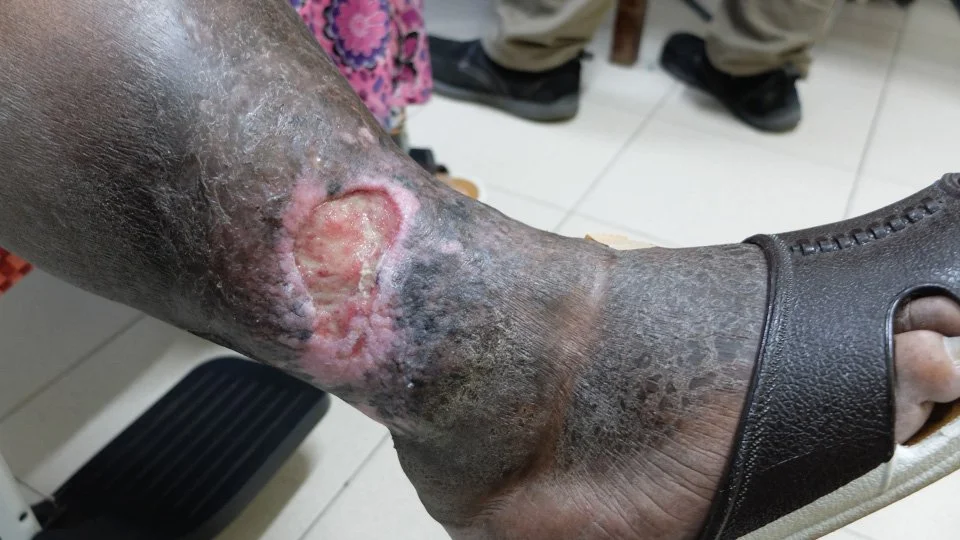Leg ulcers
What are Leg Ulcers?
Leg ulcers are open wounds or sores that develop on the leg and take more than two weeks to heal, even with proper care. These ulcers typically appear between the ankle and knee and can be quite painful. If left untreated, they can grow larger and increase the risk of infection.


Types of Leg Ulcers
Venous leg ulcers: These are the most common type, accounting for about 80% of all leg ulcers. They are caused by poor circulation due to malfunctioning valves in the leg veins. These valves normally prevent blood from flowing backward. When they become weak or damaged, blood pools in the legs, increasing pressure in the veins and damaging the skin.
Arterial leg ulcers: These ulcers develop due to a lack of blood flow caused by blocked arteries. This can be a result of peripheral artery disease (PAD), a condition where fatty deposits build up in the arteries, narrowing them and restricting blood flow to the legs. Arterial leg ulcers are typically located on the toes, feet, or lower legs and may appear deeper and more painful than venous ulcers.
Other leg ulcers: These can be caused by various factors, such as:
- Diabetes: Can damage nerves and blood vessels in the legs, increasing the risk of skin breakdown and ulcers.
- Autoimmune diseases: Conditions like rheumatoid arthritis can cause inflammation in the legs and contribute to ulcer formation.
- Trauma: Injuries to the leg can damage the skin and underlying tissues, increasing the risk of ulcers, especially if circulation is poor.
- Infections: Bacterial or fungal infections can cause ulcers, particularly in people with weakened immune systems.
Traditional vs. Modern Understanding of Leg Ulcers
Previously, leg ulcers were primarily seen as a localized skin problem. Treatment often focused solely on cleaning and dressing the wound itself. However, modern medicine recognizes leg ulcers as a symptom of an underlying condition affecting blood circulation or skin health. This shift in understanding allows for more targeted treatment addressing the root cause and promoting faster healing.
Understanding Leg Ulcers and Treatment
Leg ulcers can develop due to various underlying conditions affecting blood flow or skin health. Effective treatment focuses on addressing the underlying cause, promoting healing of the ulcer itself, and preventing new ulcers from forming. The specific treatment plan will vary depending on the type and severity of the ulcer. This may involve:
Wound care: This includes cleaning and dressing the wound to prevent infection and promote healing. Different types of dressings may be used depending on the stage of healing.
Compression therapy: Compression stockings or bandages help to improve blood circulation in the legs and reduce swelling.
Medications: Depending on the underlying cause, medications may be prescribed to improve blood flow, manage diabetes, or reduce inflammation.
Minimally invasive procedures: In some cases, minimally invasive procedures may be used to address problems with the veins, such as laser treatment or ablation techniques.
Advancements in Treating Leg Ulcers
Research into leg ulcers is ongoing, leading to new and improved treatments. These may include:
Advanced wound dressings: New types of dressings can help create a moist wound environment that promotes healing and reduces pain.
Minimally invasive procedures: Techniques like vein ablation or stenting can improve blood flow in the legs without the need for major surgery.
Medications: New medications are being developed to improve blood flow, manage chronic conditions like diabetes, and promote wound healing.
If you have a leg ulcer that won’t heal, it’s crucial to consult a healthcare professional for proper diagnosis and treatment. Early intervention can help prevent complications and promote faster healing.
We at Veins and Foot Clinic are committed to providing comprehensive care for leg ulcers. Our team of experienced professionals can help diagnose the underlying cause of your ulcer and develop a personalized treatment plan to promote healing and prevent recurrence.
Don’t let vein issues affect your life.
Book a call with us
Treatments for Venous Leg Ulcers
Venaseal Glue Treatment
- Can be performed in the office/outpatient environment
- Is relatively painless?
- Very little bruising of the leg
- Minimal local anaesthetic required.
- Return to work within 24 hours.
Radiofrequency Vein Ablation
- Gold standard treatment of varicose veins (along with endovenous laser ablation)
- Keyhole treatment
- Relatively painless and return to work within 24 hours
- Useful in treating primary varicose veins
Closure Treatment
- Same day procedure
- Fast recovery – resuming normal activities within 1-2 days
- Minimal or no scarring
EndoVenous Laser Ablation
- Keyhole treatment
- All varicose vein sizes can be treated.
- Relatively painless with return to work within 24 hours
- Useful in treating primary and secondary varicose veins
Ultrasound – Guided Foam Sclerotherapy
- Keyhole treatment
- Useful in treating recurrent varicose veins
- Outpatient/office based treatment
- Compliments: laser and radio frequency treatment of varicose veins
- Relatively cheap
Vein Check-up
- At the Vein and Foot Clinic, we offer an early detection service for the potential risk of developing thread veins, varicose veins, pelvic varicose veins, and deep vein thrombosis (DVT).
Conditions We Treat
- Varicose veins
- Superficial Venous Thrombosis Phlebitis
- Thread / spider veins
- Swollen leg
- Deep vein thrombosis (DVT)
- May turners syndrome
- Varicose veins in pregnancy
- Varicose veins in obese patients
- Restless leg syndrome
- Varicose veins of the testicles
- Recurrent Varicose Veins
- Hidden Varicose Veins
- Hemosiderin Brown Stains
- Lipo dermatosclerosis (LDS)
- Venous Eczema
- Leg Ulcers
- Vaginal and Vulval Varicose Veins
- Pelvic Congestion Syndrome (PCS)

